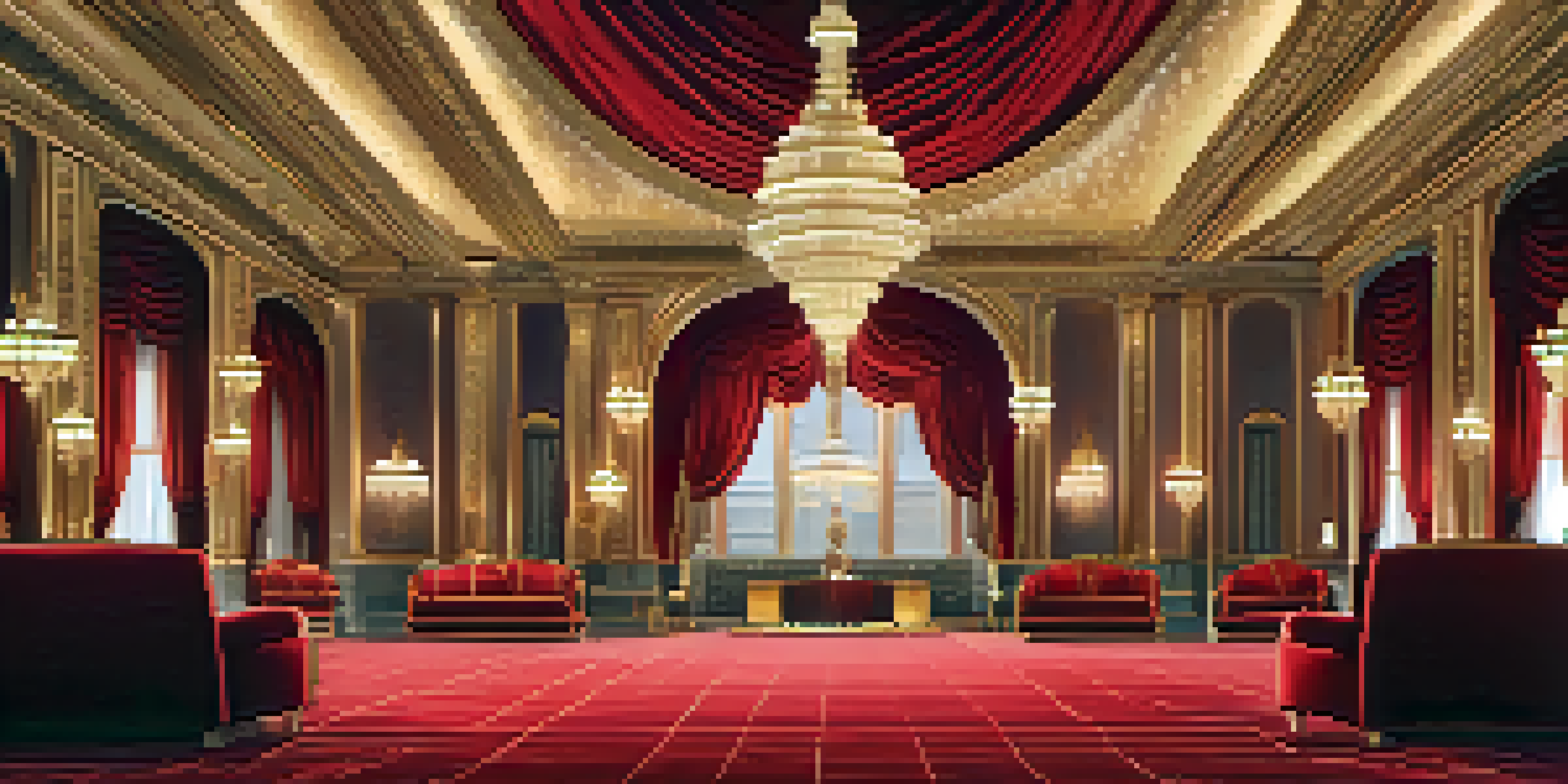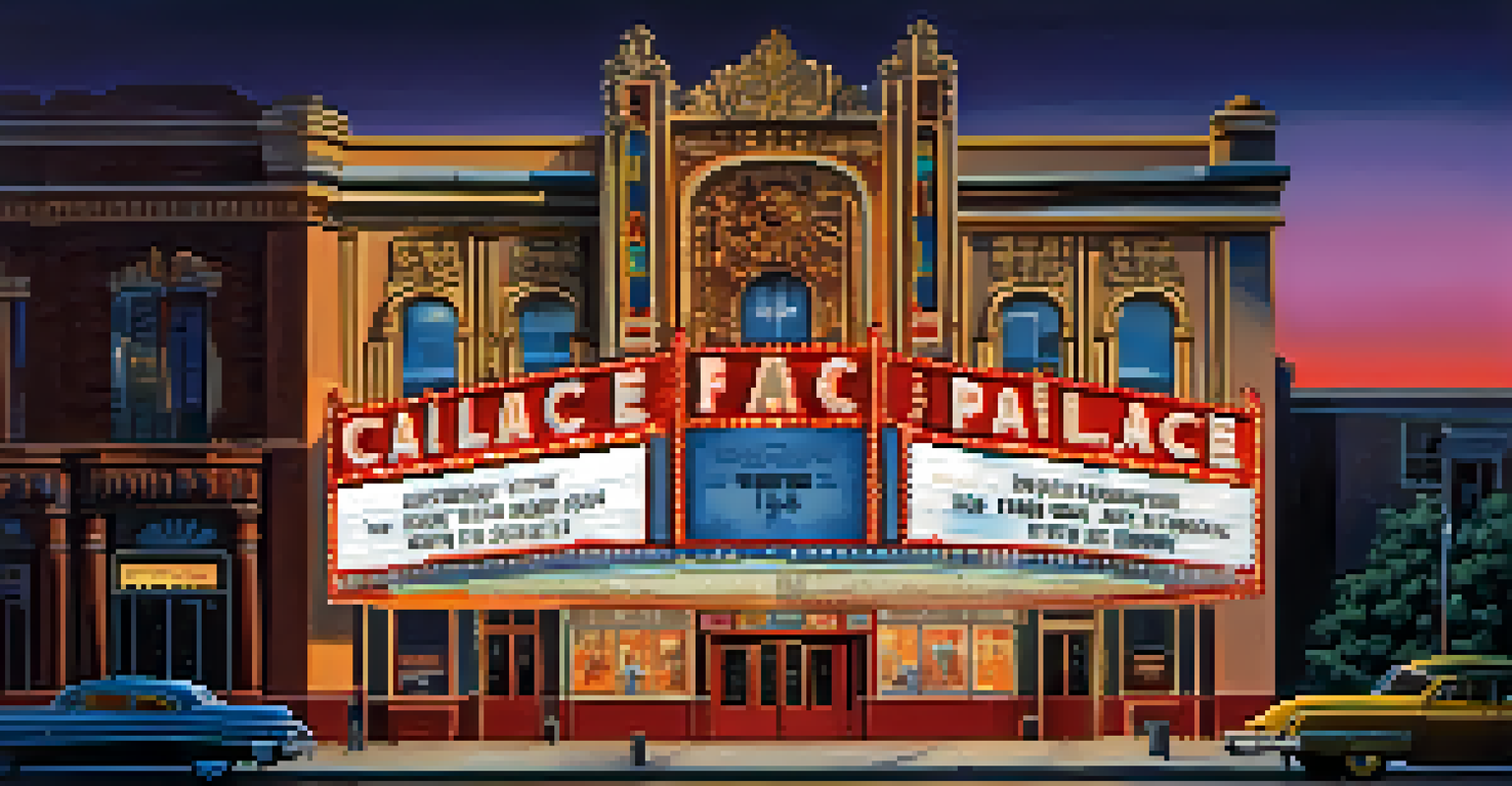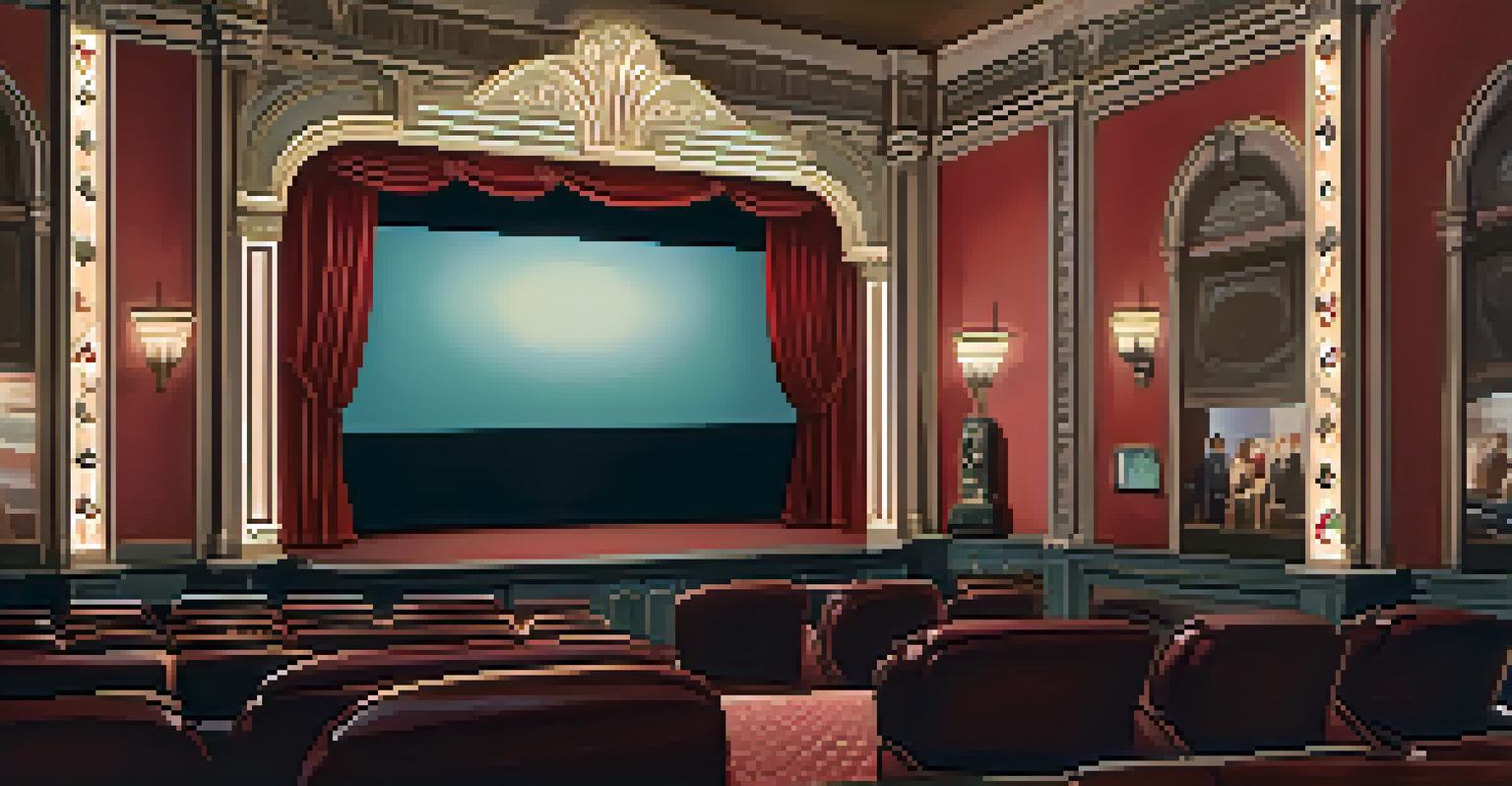The Golden Age of Hollywood: The Rise of Movie Palaces

The Birth of Movie Theaters in the Early 20th Century
In the early 1900s, the landscape of entertainment began to change dramatically with the advent of movie theaters. Initially, films were shown in small venues, often referred to as nickelodeons, where patrons would pay just a nickel to enjoy a short film. These spaces were modest, but they laid the groundwork for something bigger and more grandiose.
Cinema is a matter of what's in the frame and what's out of it.
As the film industry began to grow, so did the audience's appetite for more elaborate viewing experiences. The rise of silent films in the 1920s captivated audiences, and the demand for larger, more luxurious theaters became apparent. This marked the beginning of the movie palace phenomenon, as filmmakers and entrepreneurs alike sought to create spaces that offered not just films but a complete experience.
The transition from humble nickelodeons to movie palaces was more than just physical; it reflected a shift in societal values. Cinema was becoming a major form of entertainment, and with it came the desire for grandeur, comfort, and opulence, which would soon be embodied by the magnificent movie palaces.
Architectural Marvels: The Design of Movie Palaces
Movie palaces were not just places to watch films; they were architectural masterpieces that dazzled the senses. Designed with intricate details, these theaters often featured lavish interiors, grand staircases, and stunning chandeliers that transported audiences to another world. Imagine stepping into a place that felt like a palace—complete with ornate ceilings and plush seating.

The designs were heavily influenced by various architectural styles, including Art Deco, Moorish, and even Byzantine elements. Each theater was unique, boasting its own flair, yet they all shared an air of sophistication that made the cinema-going experience feel special. The attention to detail was astounding, as architects aimed to create spaces that would leave a lasting impression on their patrons.
Rise of Movie Theaters
The early 20th century saw the transition from small nickelodeons to grand movie palaces, reflecting a societal shift towards luxurious entertainment experiences.
Beyond aesthetics, the architecture also served practical purposes. The layout was carefully planned to optimize acoustics and sightlines, ensuring that every audience member could fully enjoy the film. This combination of beauty and functionality solidified movie palaces as cultural landmarks in their communities.
The Role of Movie Palaces in the Film Industry
Movie palaces played a crucial role in the success of the film industry, acting as the primary venues for film distribution and exhibition. These grand theaters were essential for premieres and special screenings, often showcasing the latest cinematic masterpieces to eager audiences. The glitz and glamour of a movie palace added to the excitement surrounding new film releases, making them events to remember.
The movies are a door to a world that is filled with magic and wonder, and that should never be lost.
Moreover, the experience of watching a film in a movie palace was a social affair. Families, couples, and friends would gather to enjoy not just the film but the entire atmosphere, creating a sense of community. The excitement surrounding new releases often led to long lines and sold-out showings, a testament to the allure of these majestic venues.
As Hollywood's star system began to emerge, movie palaces became synonymous with fame and celebrity. Stars would often make appearances at premieres, adding to the allure and drawing even larger crowds. This connection between Hollywood's elite and the opulence of movie palaces helped cement their status as cultural icons.
The Golden Age of Hollywood: A Cultural Shift
The Golden Age of Hollywood, spanning the 1920s to the 1960s, was a time of immense creativity and transformation in the film industry. During this period, the movie palace became a symbol of not only entertainment but also cultural aspiration. These theaters represented a new social norm where attending a film was a prestigious outing.
This era also saw the rise of the studio system, where major studios produced films in a factory-like manner. As studios churned out hit after hit, movie palaces became the primary venues for showcasing these films, resulting in a symbiotic relationship between theaters and studios. As a result, movie palaces were often filled with eager audiences, ready to be entertained.
Architectural Significance
Movie palaces were not only venues for films but also architectural masterpieces that combined beauty and functionality, enhancing the cinema-going experience.
The cultural impact of this era extended beyond the silver screen. The popularity of films inspired fashion trends, music, and even social movements. Movie palaces, with their glamorous allure, were at the heart of this cultural renaissance, shaping public tastes and preferences in profound ways.
The Decline of Movie Palaces in the Late 20th Century
As the decades rolled on, the excitement of the Golden Age began to wane, leading to a decline in the prominence of movie palaces. The introduction of television in the 1950s changed the way people consumed entertainment, offering a more convenient option for families to watch films from the comfort of their homes. This shift significantly impacted the attendance at movie theaters.
Additionally, the rise of multiplexes in the 1980s contributed to the decline of traditional movie palaces. These new venues offered multiple screens and a wider variety of films, but often at the expense of the grandeur and charm that defined earlier theaters. As a result, many historic movie palaces were closed, repurposed, or left to decay.
Despite this decline, the legacy of movie palaces has not been forgotten. Many have been preserved as historic landmarks, serving as a reminder of a bygone era. Efforts to restore and revitalize these theaters highlight the ongoing appreciation for the architectural beauty and cultural significance they hold.
Revival and Preservation: The Future of Movie Palaces
In recent years, there has been a renewed interest in preserving movie palaces, sparked by nostalgia and a desire for authentic experiences. Many cities have initiated restoration projects to breathe new life into these historic theaters, transforming them into vibrant cultural hubs. This revival showcases a commitment to preserving the rich history of cinema.
Modern technology has found its way into these restored venues, blending the old with the new. Enhanced sound systems and digital projection have been integrated into the classic architecture, allowing audiences to enjoy films while experiencing the charm of a vintage movie palace. This combination of nostalgia and contemporary advancements attracts a diverse audience.
Cultural Impact and Revival
Despite a decline in the late 20th century, the revival and preservation of movie palaces highlight their lasting cultural significance and the communal experience of cinema.
Moreover, the resurgence of classic films and themed screenings has made movie palaces relevant once again, creating a unique atmosphere that cannot be replicated at home. As more communities recognize the value of these historic theaters, the future looks promising for movie palaces, ensuring that they remain a cherished part of our cultural landscape.
The Impact of Movie Palaces on Modern Cinema Culture
Today, the influence of movie palaces can still be felt in the way we experience films. While the landscape of cinema has changed dramatically with streaming services and home theaters, the communal experience of watching a film on a big screen remains unmatched. Movie palaces foster a sense of connection among audiences, allowing them to share in the magic of storytelling together.
The allure of a grand theater experience continues to draw moviegoers seeking something more than just a film. Events like film festivals, classic movie nights, and special screenings have found a home in these historic venues, celebrating the art of cinema. This cultural appreciation reinforces the idea that movie palaces are not just relics of the past but active participants in today’s film culture.

As we navigate the evolving landscape of cinema, the legacy of movie palaces serves as a reminder of the importance of preserving our cultural heritage. They symbolize a time when film was a communal experience, and their revival offers a glimpse into the potential future of cinema—one that honors tradition while embracing innovation.